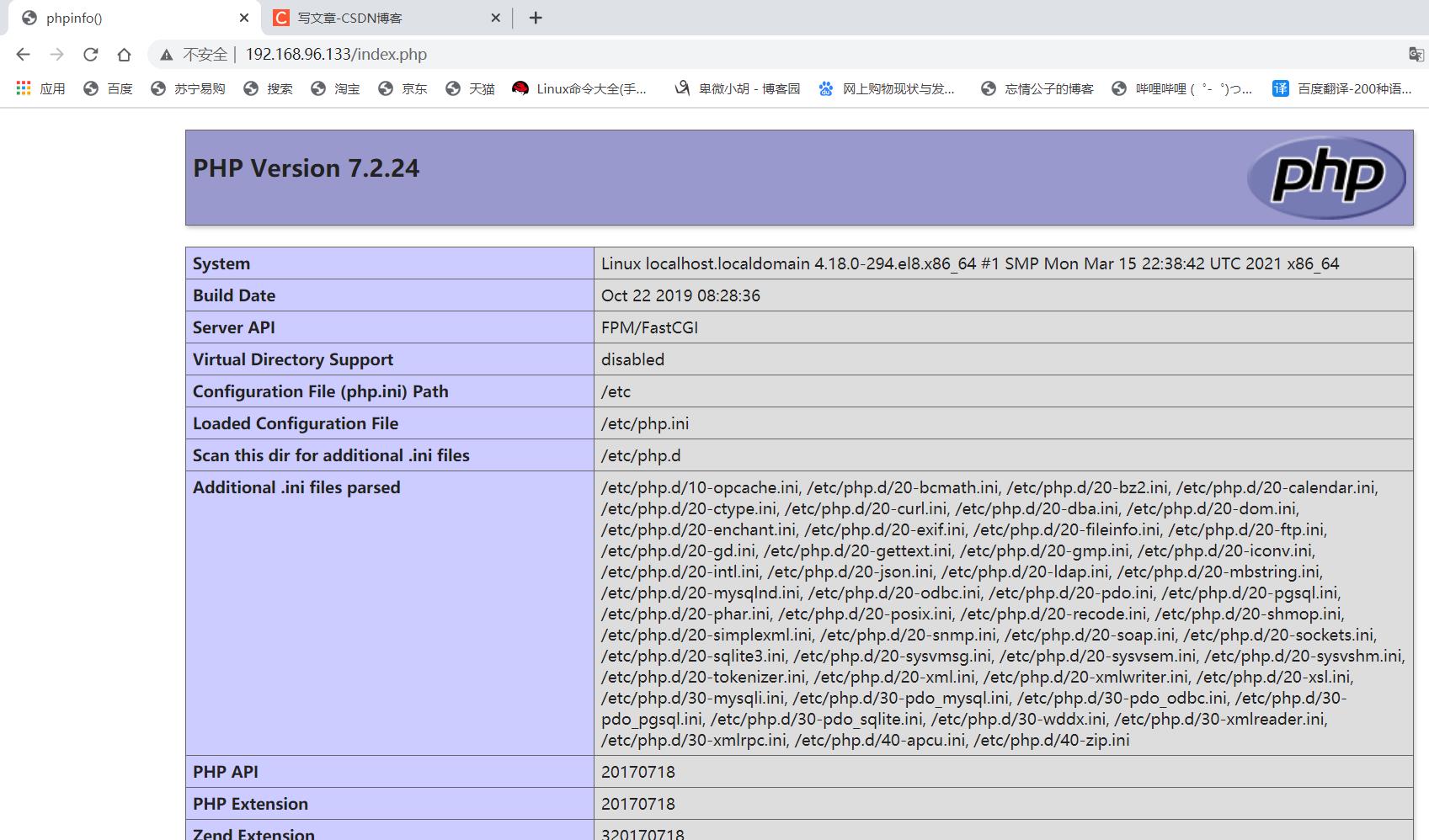nginx实现负载均衡和动静分离
Posted 卑微小胡
tags:
篇首语:本文由小常识网(cha138.com)小编为大家整理,主要介绍了nginx实现负载均衡和动静分离相关的知识,希望对你有一定的参考价值。
反向代理与负载均衡
nginx`通常被用作后端服务器的反向代理,这样就可以很方便的实现动静分离以及负载均衡,从而大大提高服务器的处理能力。
nginx实现动静分离,其实就是在反向代理的时候,如果是静态资源,就直接从nginx发布的路径去读取,而不需要从后台服务器获取了。
但是要注意,这种情况下需要保证后端跟前端的程序保持一致,可以使用Rsync做服务端自动同步或者使用NFS、MFS分布式共享存储。
Http Proxy`模块,功能很多,最常用的是`proxy_pass`和`proxy_cache
如果要使用proxy_cache,需要集成第三方的ngx_cache_purge模块,用来清除指定的URL缓存。这个集成需要在安装nginx的时候去做,如:
./configure --add-module=../ngx_cache_purge-1.0 ......
nginx通过upstream模块来实现简单的负载均衡,upstream需要定义在http段内
在upstream段内,定义一个服务器列表,默认的方式是轮询,如果要确定同一个访问者发出的请求总是由同一个后端服务器来处理,可以设置ip_hash,如:
upstream idfsoft.com {
ip_hash;
server 127.0.0.1:9080 weight=5;
server 127.0.0.1:8080 weight=5;
server 127.0.0.1:1111;
}
注意:这个方法本质还是轮询,而且由于客户端的ip可能是不断变化的,比如动态ip,代理,翻墙等,因此ip_hash并不能完全保证同一个客户端总是由同一个服务器来处理。
定义好upstream后,需要在server段内添加如下内容:
server {
location / {
proxy_pass http://idfsoft.com;
}
}
| 主机名 | ip | 服务 |
|---|---|---|
| c1 | 192.168.96.129 | lnmp |
| c2 | 192.168.96.133 | nginx |
| c3 | 192.168.96.134 | apache |
c1部署lnmp
安装nginx
#关闭防火墙和selinx
[root@localhost ~]# systemctl disable firewalld
[root@localhost ~]# vim /etc/selinux/config
SELINUX=disabled
#创建系统用户nginx
[root@localhost ~]# useradd -r -M -s /sbin/nologin nginx
#安装依赖环境
[root@localhost ~]# yum -y install pcre-devel openssl openssl-devel gd-devel gcc gcc-c++ make
#安装过程略....
[root@localhost ~]# yum -y groups mark install 'Development Tools'
#创建日志存放目录
[root@localhost ~]# mkdir -p /var/log/nginx
[root@localhost ~]# chown -R nginx.nginx /var/log/nginx
#下载nginx
[root@localhost ~]# wget https://nginx.org/download/nginx-1.20.1.tar.gz
[root@localhost ~]# ls
anaconda-ks.cfg nginx-1.20.1.tar.gz
编译安装
[root@localhost ~]# tar xf nginx-1.20.1.tar.gz
[root@localhost ~]# ls
anaconda-ks.cfg nginx-1.20.1 nginx-1.20.1.tar.gz
[root@localhost ~]# cd nginx-1.20.1
[root@localhost nginx-1.20.1]# ./configure \\
> --prefix=/usr/local/nginx \\
> --user=nginx \\
> --group=nginx \\
> --with-debug \\
> --with-http_ssl_module \\
> --with-http_realip_module \\
> --with-http_image_filter_module \\
> --with-http_gunzip_module \\
> --with-http_gzip_static_module \\
> --with-http_stub_status_module \\
> --http-log-path=/var/log/nginx/access.log \\
> --error-log-path=/var/log/nginx/error.log
[root@localhost nginx-1.20.1]# make
[root@localhost nginx-1.20.1]# make install
nginx安装后配置
#配置环境变量
[root@localhost ~]# echo 'export PATH=/usr/local/nginx/sbin:$PATH' > /etc/profile.d/nginx.sh
[root@localhost ~]# source /etc/profile.d/nginx.sh
//服务控制方式,使用nginx命令
-t //检查配置文件语法
-v //输出nginx的版本
-c //指定配置文件的路径
-s //发送服务控制信号,可选值有{stop|quit|reopen|reload}
#输出nginx的版本
[root@localhost ~]# nginx -v
nginx version: nginx/1.20.1
#查看nginx有那些功能
[root@localhost ~]# nginx -V
nginx version: nginx/1.20.1
built by gcc 8.5.0 20210514 (Red Hat 8.5.0-2) (GCC)
built with OpenSSL 1.1.1k FIPS 25 Mar 2021
TLS SNI support enabled
configure arguments: --prefix=/usr/local/nginx --user=nginx --group=nginx --with-debug --with-http_ssl_module --with-http_realip_module --with-http_image_filter_module --with-http_gunzip_module --with-http_gzip_static_module --with-http_stub_status_module --http-log-path=/var/log/nginx/access.log --error-log-path=/var/log/nginx/error.log
#检查配置文件
[root@localhost ~]# nginx -t
nginx: the configuration file /usr/local/nginx/conf/nginx.conf syntax is ok
nginx: configuration file /usr/local/nginx/conf/nginx.conf test is successful
[root@localhost ~]# nginx
[root@localhost ~]# ss -antl
State Recv-Q Send-Q Local Address:Port Peer Address:Port Process
LISTEN 0 128 0.0.0.0:80 0.0.0.0:*
LISTEN 0 128 0.0.0.0:22 0.0.0.0:*
LISTEN 0 128 [::]:22 [::]:*
安装mysql
安装php
运行以下命令添加并更新epel源
[root@localhost ~]# dnf -y install epel-release
[root@localhost ~]# dnf update epel-release
运行以下命令删除缓存的无用软件包并更新软件源。
[root@localhost ~]# dnf clean all
[root@localhost ~]# dnf makecache
启用php:7.3模块
[root@localhost ~]# dnf module enable php:7.3
运行以下命令安装PHP相应的模块
[root@localhost ~]# dnf install php php-curl php-dom php-exif php-fileinfo php-fpm php-gd php-hash php-json php-mbstring php-mysqli php-openssl php-pcre php-xml libsodium
#安装过程省略
#查看PHP版本
[root@localhost ~]# php -v
PHP 7.3.20 (cli) (built: Jul 7 2020 07:53:49) ( NTS )
Copyright (c) 1997-2018 The PHP Group
Zend Engine v3.3.20, Copyright (c) 1998-2018 Zend Technologies
配置Nginx
[root@localhost ~]# vi /usr/local/nginx/conf/nginx.conf
location / {
root html;
fastcgi_pass 127.0.0.1:9000;
fastcgi_index index.php;
#添加默认首页信息index.php。
index index.html index.htm index.php;
}
#去掉被注释的location ~ \\.php$大括号内容前的#,并修改大括号的内容。修改完成如下所示
location ~ \\.php$ {
proxy_pass http://127.0.0.1;
root /usr/local/nginx/html;
#Nginx通过unix套接字与PHP-FPM建立联系,该配置与/etc/php-fpm.d/www.conf文件内的listen配置一致。
fastcgi_pass unix:/run/php-fpm/www.sock;
fastcgi_index index.php;
fastcgi_param SCRIPT_FILENAME $document_root$fastcgi_script_name;
#Nginx调用fastcgi接口处理PHP请求。
include fastcgi_params;
}
[root@localhost ~]# nginx -s stop
[root@localhost ~]# nginx
配置PHP
[root@localhost ~]# vim /etc/php-fpm.d/www.conf
#找到user = apache和group = apache,将apache修改为nginx
user = nginx
; RPM: Keep a group allowed to write in log dir.
group = nginx
#新建phpinfo.php文件,用于展示PHP信息
[root@localhost ~]# vim /usr/local/nginx/html/phpinfo.php
#输入下列内容,函数phpinfo()会展示PHP的所有配置信息。
<?php echo phpinfo(); ?>
#运行以下命令启动PHP-FPM
[root@localhost ~]# systemctl start php-fpm
#运行以下命令设置PHP-FPM开机自启动
[root@localhost ~]# systemctl enable php-fpm
c2部署nginx和c1安装的步骤一样
c3部署apache
安装httpd
[root@localhost ~]# dnf -y groups mark install "Development Tools"
[root@localhost ~]# useradd -r -M -s /sbin/nologin apache
[root@localhost ~]# dnf -y install openssl-devel pcre-devel expat-devel libtool gcc gcc-c++ make bzip2 openssl
[root@localhost ~]# tar xf apr-1.7.0.tar.bz2
[root@localhost ~]# tar xf apr-util-1.6.1.tar.bz2
[root@localhost ~]# tar xf httpd-2.4.43.tar.bz2
[root@localhost ~]# ls
anaconda-ks.cfg apr-util-1.6.1.tar.bz2
apr-1.7.0 httpd-2.4.43
apr-1.7.0.tar.bz2 httpd-2.4.43.tar.bz2
apr-util-1.6.1 mysql-5.7.33-linux-glibc2.12-x86_64.tar.gz
[root@localhost ~]# cd apr-1.7.0
[root@localhost apr-1.7.0]# ls
apr-config.in build-outputs.mk helpers misc strings
apr.dep CHANGES include mmap support
apr.dsp CMakeLists.txt libapr.dep network_io tables
apr.dsw config.layout libapr.dsp NOTICE test
apr.mak configure libapr.mak NWGNUmakefile threadproc
apr.pc.in configure.in libapr.rc passwd time
apr.spec docs LICENSE poll tools
atomic dso locks random user
build emacs-mode Makefile.in README
build.conf encoding Makefile.win README.cmake
buildconf file_io memory shmem
[root@localhost apr-1.7.0]# vim configure
$RM "$cfgfile" #删除或注释此行
[root@localhost apr-1.7.0]# ./configure --prefix=/usr/local/apr
[root@localhost apr-1.7.0]# make
[root@localhost apr-1.7.0]# make install
[root@localhost apr-1.7.0]# cd ../apr-util-1.6.1
[root@localhost apr-util-1.6.1]# ./configure --prefix=/usr/local/apr-util --with-apr=/usr/local/apr
[root@localhost apr-util-1.6.1]# make
[root@localhost apr-util-1.6.1]# make install
[root@localhost apr-util-1.6.1]cd ../httpd-2.4.43
[root@localhost httpd-2.4.43]# ./configure --prefix=/usr/local/apache \\
--sysconfdir=/etc/httpd24 \\
--enable-so \\
--enable-ssl \\
--enable-cgi \\
--enable-rewrite \\
--with-zlib \\
--with-pcre \\
--with-apr=/usr/local/apr \\
--with-apr-util=/usr/local/apr-util/ \\
--enable-modules=most \\
--enable-mpms-shared=all \\
--with-mpm=prefork
[root@localhost httpd-2.4.43]# make
[root@localhost httpd-2.4.43]# make install
#安装后配置
[root@localhost ~]# echo 'export PATH=/usr/local/apache/bin:$PATH' > /etc/profile.d/httpd.sh
[root@localhost ~]# source /etc/profile.d/httpd.sh
[root@localhost ~]# ln -s /usr/local/apache/include/ /usr/include/httpd
[root@localhost ~]# echo 'MANPATH /usr/local/apache/man' >> /etc/man.config
[root@localhost ~]# apachectl start
[root@localhost ~]# ss -antl
State Recv-Q Send-Q Local Address:Port Peer Address:Port Process
LISTEN 0 128 0.0.0.0:22 0.0.0.0:*
LISTEN 0 128 *:80 *:*
LISTEN 0 128 [::]:22 [::]:*
[root@localhost ~]# systemctl stop firewalld
[root@localhost ~]# setenforce 0
[root@localhost ~]# systemctl disable firewalld
Removed /etc/systemd/system/multi-user.target.wants/firewalld.service.
Removed /etc/systemd/system/dbus-org.fedoraproject.FirewallD1.service.
配置nginx主机的nginx配置文件
[root@nginx ~]# vim /usr/local/nginx/conf/nginx.conf
location / {
root html; #删掉这两行
index index.html index.htm;
}
在server上面添加
upstream html {
server 192.168.96.129;
}
upstream php {
server 192.168.96.134;
}
在location下
location / {
proxy_pass http://html; #改成这个
}
把下面的\\.php的取消注释
location ~ \\.php$ {
proxy_pass http://php; #添加这一行
}
效果


以上是关于nginx实现负载均衡和动静分离的主要内容,如果未能解决你的问题,请参考以下文章